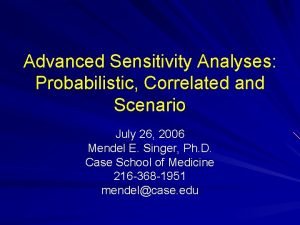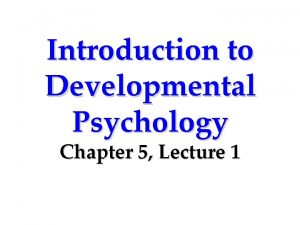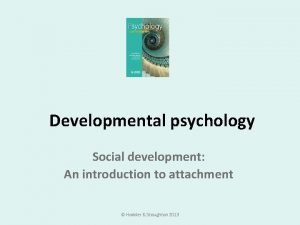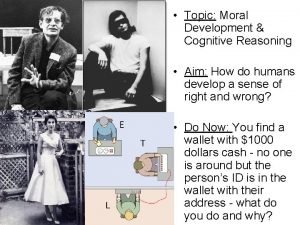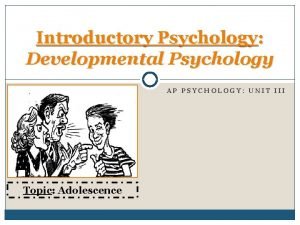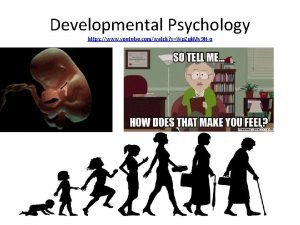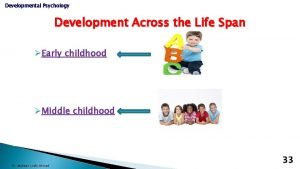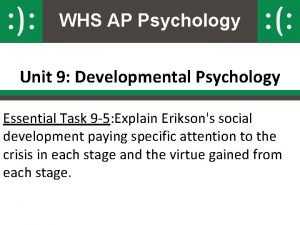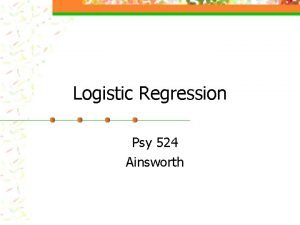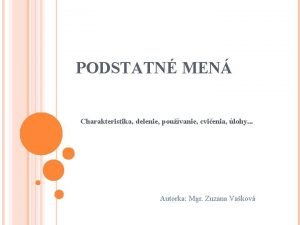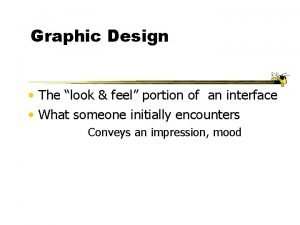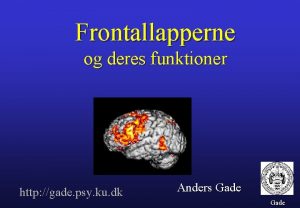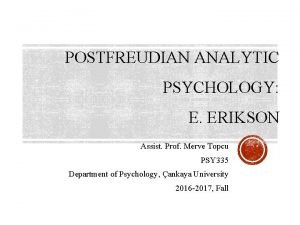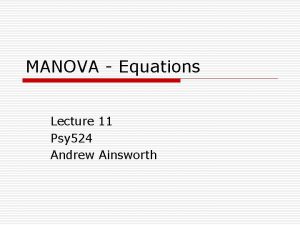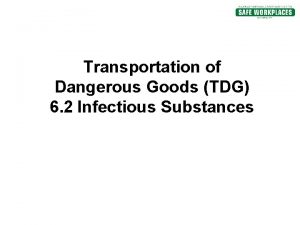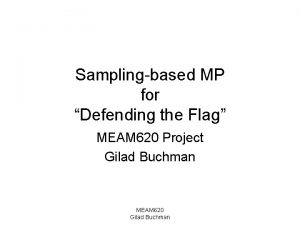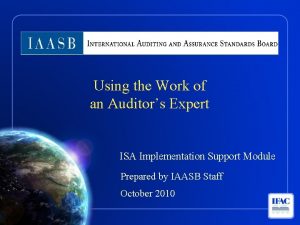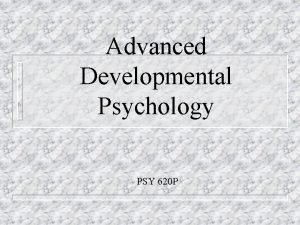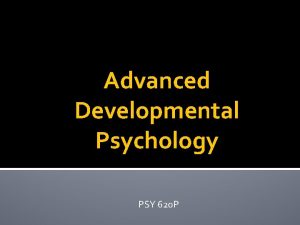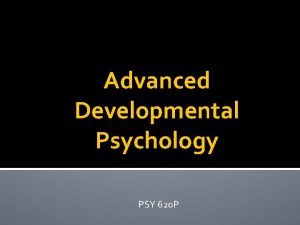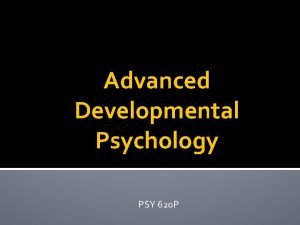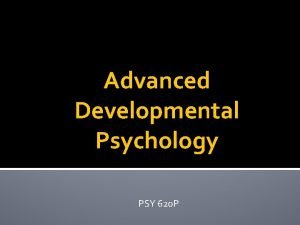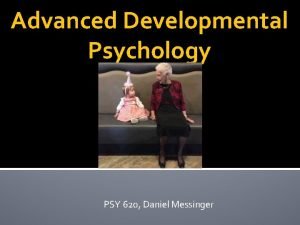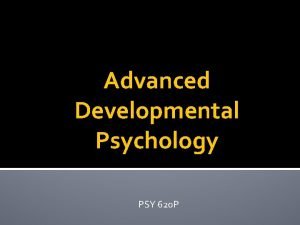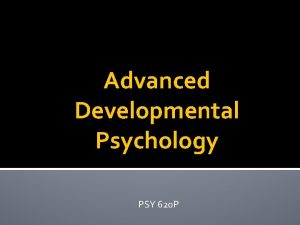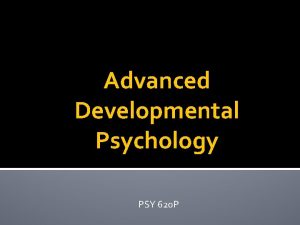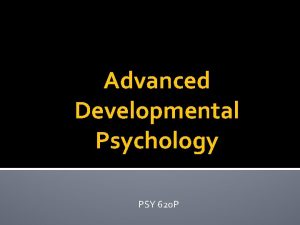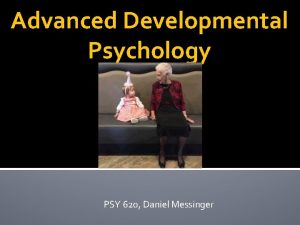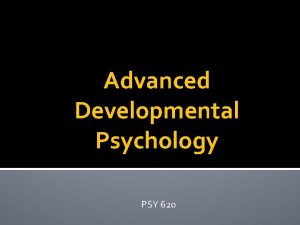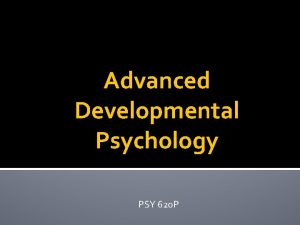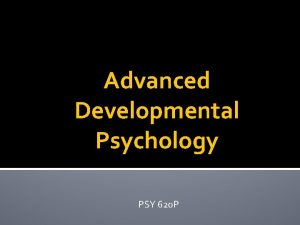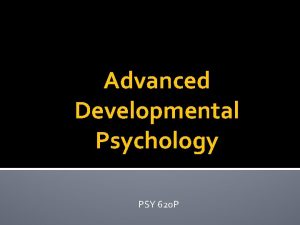Advanced Developmental Psychology PSY 620 P Parenting Sensitivity















































- Slides: 47

Advanced Developmental Psychology PSY 620 P

Parenting �Sensitivity security �Is sensitivity maximal responsivity? �Sensitivity/security outcome �Early sensitivity Academic outcome �Preschool rule-breaking parental power assertion antisociality (effects on parenting) �Spanking poor academic & social outcomes Single study Meta-analysis �Maternal warmth & intrusiveness Interaction in AA dyads (Ispa)

Sensitivity attachment security �Intervention experiments Dutch irritable babies—responsivity intervention Low-SES babies--Snugglies �Meta-analysis Perceive signals accurately and respond promptly and appropriately 22% (r =. 22), 7, 223 infants in 123 comparisons De Wolff, M. , & van Ijzendoorn, M. H. (1997). Sensitivity and attachment: A meta-analysis on parental antecedents of infant attachment. Child Development, 68(4), 571 -591. Messinger 3

Borstein & Manian (2013) Hudiburgh

The Role of Maternal Responsiveness � Question: “How are global judgements of maternal parenting sensitivity assigned to levels of specific maternal contingent responsiveness to specific infant behaviors? ” � Why do we care? Maternal responsiveness has often been recognized as important in child development Past studies have found that maternal unresponsiveness predicts later insecure attachment, aggressive and disruptive behaviors, and externalizing problems However, it has also been posited that overcontigency may interfere with infant development of self-reliance and self-sufficiency Hudiburgh

The Role of Maternal Responsiveness � A curvilinear relationship? Past studies suggest that both over- and under-contingency to young infants may negatively impact development ▪ Intermediate levels of contingency secure attachment ▪ Over-/under-contingency insecure attachment � However, these studies have focused on the relationship between responsiveness and child outcomes � The current study seeks to understand how maternal responsiveness is related to independent ratings of global maternal sensitivity Hudiburgh

Current Study Aims & Hypotheses � More specifically the current study seeks to address the following: 1. How does maternal contingency vary by different responses and to different infant behaviors? 2. How can levels of maternal contingency be quantified in ways that go beyond the usual qualitative attributions (e. g. “low”/”mid-range”/”high”)? 3. What quantitative levels of maternal contingency are judged to be optimally sensitive? Hypothesis: Maternal over- and undercontingency will be rated as generally less sensitive, whereas levels surrounding significant maternal contingency will be rated optimally sensitive. Hudiburgh

Method � Participants 335 European American mother-infant dyads Infant age ranged from 4. 7 -6. 5 months (M age = 5. 4 months) Mother age ranged from 13. 91 -42. 28 years (M age = 28. 27 years) Heterogeneous in terms of of maternal education and family SES � Procedure Hour-long audiovisual recording conducted in the home Mothers were asked to go about their normal routine Observations included a variety of activities (feeding, diapering, bathing, playing) Recordings took place during a time when the child was awake and alert, when mothers were in view of the infant and solely responsible for the baby Hudiburgh

Method � Coding took two forms: Micro-level coding of infant/maternal behaviors Macro-level coding of maternal sensitivity � Coding of infant/maternal behaviors: Coded onset/offset of specific infant/mother behaviors (see table) Looked at each possible pairing of infant mother behavior Mother’s behavior considered “contingent” if it occurred within 3 seconds of infant behavior onset or offset (depending on the pairing) Infant Mother Look at mother Encourage attention to mother Look at object Encourage attention to object Nondistress vocalization Speech to the infant Smile Hudiburgh

Method � Coding of maternal sensitivity: The same recordings were evaluated by independent coders Sensitivity Scale from the Emotional Availability Scales: Infancy to Early Childhood Version (EA Scales) Maternal sensitivity scored from 1 (highly insensitive) to 9 (highly sensitive) Hudiburgh

Correlations between Behaviors Hudiburgh

Contingency of Mother Behaviors • ORs > 1: indicate that the mother’s behavior was more likely to begin within 3 s of the infant behavior than at other times • ORs = 0 -1: indicate less likelihood Hudiburgh

Contingency & Sensitivity Only 2 correlations between infant-mother behavior ORs and ratings of maternal sensitivity were significant � Method of analysis may be masking nonlinear associations between maternal contingency and sensitivity � Solution: spline regressions! “knot” Hudiburgh

Contingency & Sensitivity Hudiburgh

Summary Current study sought to better understand the relationship between the contingency of maternal responses and perceived maternal sensitivity For most infant-mother behavioral pairings, contingency odds ratios just greater than 1 were deemed “optimally sensitive” In other words, greater contingency did not translate into greater sensitivity ratings in a “dose-response” manner; rather, past a certain threshold of contingency, mothers who were more contingent received lower sensitivity ratings Hudiburgh

Discussion Questions 1. To what extent do you think the results support the authors’ assertion that “some is more” when it comes to maternal contingency? 2. In the introduction, they discuss how being “continuously attentive to every infant signal” might hinder the development of self-reliance and selfsufficiency, but does the operationalization of overcontingency used in this paper (high ORs) really equate with this description? What does the mother’s behavior look like if there is a high versus low OR for a given infantmother behavioral pairing? Does this conceptualization miss anything? 3. The authors chose to specifically focus on maternal responsiveness to positive infant behaviors. Do you think the pattern seen between contingency and sensitivity would differ if they were to look at negative behaviors? 4. They also restrict their sample to European-Americans, stating that they need to better understand this basic relationship between maternal contingency and sensitivity before making the sample more diverse. Thinking about the parenting practices of other societies/cultures we’ve discussed in this class, how might the relationship between contingency and sensitivity differ (or not) for other groups? Hudiburgh

Is security a ‘vaccination’? �Most competent 3 -yr-olds have both secure attachment (at 15 mo) & (relatively) highsensitive mothering (at 24 mo) NICHD Study of Early Child Care n Insecurely attached children who subsequently experienced high-sensitive mothering significantly outperformed secure children who subsequently experienced low-sensitive mothering. n Belsky, J. and R. M. P. Fearon (2002). "Early attachment security, subsequent maternal sensitivity, and later child development: Does continuity in development depend upon continuity of caregiving? " Attachment & Human Development 4(3): 361 -387. Messinger 17

Maternal sensitivity

Are the effects of early relationship experiences enduring or transient? �Enduring Effects Model Early relationship experiences organize early developmental adaptation and continue to shape adjustment across development �Revisionist Model Early relationship experiences directly effect early childhood development but then only indirectly effect subsequent adaptation

Sensitivity social competence through age 15 1 st look Fraley, R. C. , Roisman, G. I. , & Haltigan, J. D. (2013). The legacy of early experiences in development: Formalizing 21 alternative models of how early experiences are carried forward over time. Dev Psychol, 49(1), 109 -126.

Sensitivity does not predict social competence (w covariates) Maternal Sensitivity Social and Time 1 Academic Competence at Different Times Covariates Social Competence: ΔΧ 2 = 0. 82, p =. 37 Time 2 Time 3 Time 4 Time 5 Time 6 Enduring effects of: Gender** Maternal Education** Socioeconomic Status Ethnicity

Sensitivity Academic competence (with covariates) Maternal Sensitivity Time 1 Covariates Academic Competence: ΔΧ 2 = 3. 96, p <. 05 Time 2 Time 3 Time 4 Time 5 Time 6 Enduring effects of: Gender* Maternal Education* Socioeconomic Status Ethnicity

Direct and indirect effects of fathers on development Dyadic Interactions at 24 and 36 months ▪ Three Box Task: Coded sensitivity, positive regard, cognitive stimulation, intrusiveness, detachment, negative regard �(Tamis-Le. Monda et al. , 2004)

Direct and indirect effects of fathers on development Mom/Dad behaviors correlated at each age Dad predicts mom behaviors over time but mom less predictive of dad ▪ Dad demographics (income/education) predict some aspects of parenting Dad and mom supportive parenting independently predict children’s cognitive and language outcomes �(Tamis-Le. Monda et al. , 2004)

Employed mothers: less time with infant weekdays but more time weekends (what is infant’s experience? ) Huston & Rosenkrantz Aronson (2005)


Child disregard, parental power, child antisocial associated

Child disregard parental power child antisocial for low SCL

Explanation �Early disregard for rules elicited increased parental power assertion, potentially due to those low-SCL children’s history of failing to respond to subtle, gentle punishment, and the increased power assertion resulted in future antisocial behavior. �Children with high SCL presumably respond positively to subtle parental socialization before the pressure reaches a high level.


Spanking=BAD �American Academy of Pediatrics recommends against spanking as it may be “potentially deleterious to children” Garcia; Shaffer | Mac. Kenzie et al. , 2013

Results: Prevalence of Spanking Age 3 Age 5 5% 13% Mothers 43% 48% 47% 44% Spanking child ≥ 2/week Spanking child <2/week No Spanking 3% 7% Fathers 60% Shaffer | Mac. Kenzie et al. , 2013 30% 33% 67%

Results: Spanking and Child Externalizing Problems Shaffer | Mac. Kenzie et al. , 2013

Results: Spanking and Child Receptive Vocabulary Shaffer | Mac. Kenzie et al. , 2013

Sara Wigderson 3/21/17

Results �Effect sizes were consistent Out of 111 studies, 102 demonstrated detrimental child outcomes ▪ 78 of these were statistically significant ▪ Only 1 beneficial outcome was significant 99% of sig. outcomes were detrimental Wigderson | Gershoff & Grogan-Kaylor, 2016

Results: Table 2 Wigderson | Gershoff & Grogan-Kaylor, 2016

Spanking significantly adversely associated with 13/17 outcomes Childhood: ▪ low moral internalization, aggression, antisocial behavior, externalizing behavior problems, internalizing behavior problems, mental health problems, negative parent– child relationships, impaired cognitive ability, low self-esteem, and risk of physical abuse from parents Adulthood: ▪ adult antisocial behavior, adult mental health problems, and with positive attitudes about spanking Wigderson | Gershoff & Grogan-Kaylor, 2016

Spanking and physical abuse � 7 studies (10 effect sizes) that examined both spanking and physical abuse In 3 cases, effect size for spanking was larger than physical abuse Overall effect sizes for both demonstrated detrimental outcomes (physical abuse =. 38, spanking =. 25) Wigderson | Gershoff & Grogan-Kaylor, 2016

Parenting Styles �Baumrind’s Model of Parenting Styles

Cultural differences in association between intrusiveness and warmth at 15 months? (Ispa et al. , 2004) Rubenstein

Sensitive Structuring

Maternal control and maternal warmth are central to parenting Maternal Intrusiveness • A constellation of insensitive, interfering parenting behaviors • Dominates a child’s play agenda so that the child has little or no influence on its content or pace Maternal Warmth • A mother’s physical and verbal expressions of love, attentiveness, and respect or admiration for the child Rubenstein

Maternal intrusiveness: same or different meaning across cultures? Mixed findings for maternal intrusiveness and mother-child relationship outcomes European American Negative Rubenstein non-European American Neutral Positive

Maternal Intrusiveness predicted child negativity in all ethnic groups European American intrusiveness negative changes in child engagement intrusiveness decreases in dyadic mutuality African American intrusiveness child negativity [only if low maternal warmth] More acculturated Mexican American intrusiveness decreases in dyadic mutuality Rubenstein

Dyadic Mutuality �Predictors of change in child-mother relationship variables between 15 and 25 months? Dyadic Mutuality ▪ 15 month Warmth ▪ Culture*Intrusiveness ▪ EA intrusiveness negatively predictive ▪ Non-EA groups, no association

Conclusions Maternal intrusiveness predicted negative changes in two of the three relationship outcomes (negativity and engagement) 10 months-later. The intrusiveness-negative outcomes link was moderated by ethnicity and, for African Americans, by warmth. Rubenstein
 Advanced sensitivity analysis
Advanced sensitivity analysis Chapter 5 developmental psychology
Chapter 5 developmental psychology John bowlby's attachment theory
John bowlby's attachment theory Ucf psychology requirements
Ucf psychology requirements Lawrence kohlberg developmental psychology
Lawrence kohlberg developmental psychology Personal fable ap psychology
Personal fable ap psychology Regression
Regression Research methods in developmental psychology
Research methods in developmental psychology Devonte is a graduate student in developmental psychology
Devonte is a graduate student in developmental psychology Characteristics of social development
Characteristics of social development What is psychology
What is psychology Unit 3 developmental psychology
Unit 3 developmental psychology Initiative vs guilt
Initiative vs guilt Suppose twin teenagers are vying
Suppose twin teenagers are vying Psy
Psy Nenarocny pes
Nenarocny pes Regression psy
Regression psy Phonological loop
Phonological loop Euro psy
Euro psy Psy academy
Psy academy Psy sanin
Psy sanin Pomnožné podstatné mená
Pomnožné podstatné mená Psy
Psy Psy
Psy Psy 2055
Psy 2055 Psy2055
Psy2055 Damasio
Damasio Psy
Psy Psy 335 purdue
Psy 335 purdue Psy 226
Psy 226 Psy 2055
Psy 2055 Psy walsh
Psy walsh 11 psy
11 psy Psy 421
Psy 421 Aircraft communications
Aircraft communications Packing instruction 620
Packing instruction 620 Trigo variedad jacaranda
Trigo variedad jacaranda Meam 620
Meam 620 Isa 620 using the work of an expert
Isa 620 using the work of an expert 12vac35-105-620
12vac35-105-620 Jms 620
Jms 620 Aruba captive portal 設定
Aruba captive portal 設定 Krs 620
Krs 620 Language 意味
Language 意味 Emc data domain 620
Emc data domain 620 Julius caesar buildings
Julius caesar buildings Here is where your presentation begins artinya
Here is where your presentation begins artinya Lemasters and defrain parenting styles
Lemasters and defrain parenting styles
